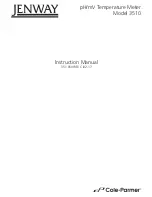
57
4.2 EARTH MEASUREMENT IN LIVE CONDITION (
REARTH)
4.2.1 DESCRIPTION OF THE FUNCTION
•
This measurement is made with a single auxiliary rod (voltage probe) connected to
terminal (P), yielding a saving of time with respect to a conventional measurement
with 2 auxiliary rods.
•
A specific additional current clamp is necessary to make a selective earth
measurement.
The instrument automatically detects the connection of the voltage and current probes.
When the TEST key is pressed, the instrument:
-
checks that the amplitude and frequency of the voltages present are correct,
-
checks the resistance of the auxiliary rod,
-
interchanges L and N internally if the 2 conductors are reversed in the socket,
-
measures the voltage between the TEST key and terminal PE,
If these quantities are correct, the instrument generates, according to the user's selection, a high
current ("tripping" mode
) or a low current ("non-tripping" mode
on 30mA RCD or
more) between terminals L and PE and measures the voltage drop between terminals P and PE.
If the user selects measurement without tripping (
), the current generated is low : the
instrument measures R
E
(global earth resistance).
Note:
if, during a earth measurement at low current, a earth fault breaker in the circuit still trips,
measure the leakage current with the current probe using the "current measurement" function of the
instrument, then change the measuring current I
TEST
(see § 4.2.2) with allowance for this leakage
current. Otherwise, short-circuit the circuit-breaker concerned and make the next measurement at
high current for greater accuracy.
If the user has selected measurement with tripping (or if they have connected the current probe to
make a selective measurement), the current generated is high (
): arrangements may have
to be made to prevent the earth fault breaker from tripping (e.g. temporary shunting of the
breaker). The instrument measures Z
E
(the global earthing impedance), R
E
and L
E
(the resistive and
inductive parts of Z
E
).
Remarks:
-
If the user selects measurement without tripping (
) and connects a current probe, the
instrument reverts to measurement with tripping and reports the change.
-
If the user connects the current probe, it is the current measured by this probe that is used to
calculate R
E
. The lower this current, the more unstable the measurement is likely to be: in this case,
smooth the measurement using the "SMOOTH" function.
4.2.2 PREPARATION FOR THE MEASUREMENT (CONNECTION)
The instrument must be connected to the network in a live condition and the earth
electrode to be measured must not be disconnected.
→
If necessary, set, in the "SET-UP" mode:
•
U
L
(see § 3.2),
•
the current generated for the measurement at low current:
Содержание C.A 6454
Страница 3: ...2...
















































